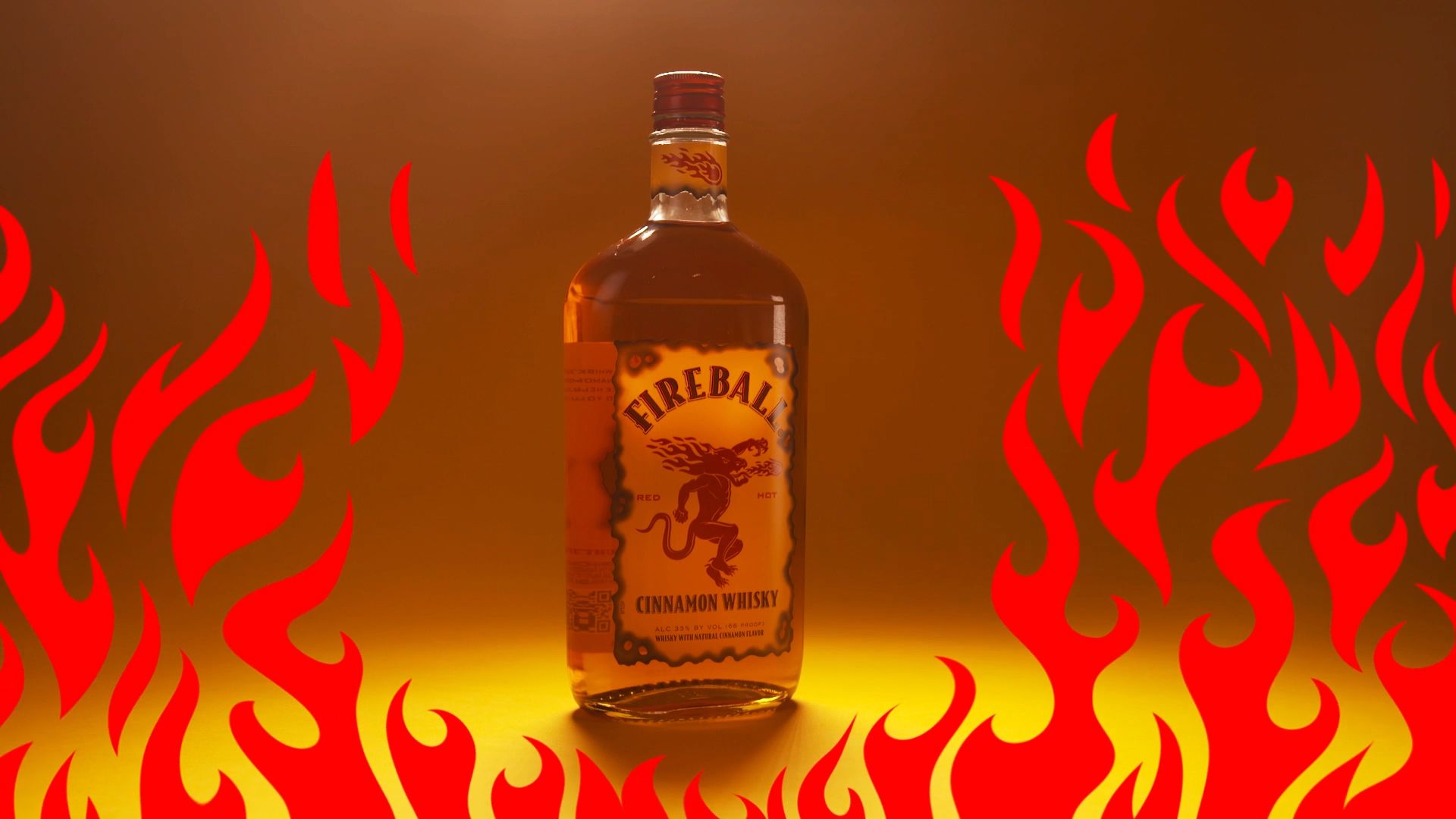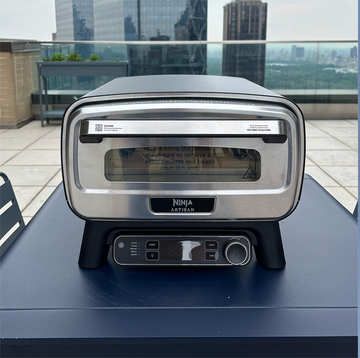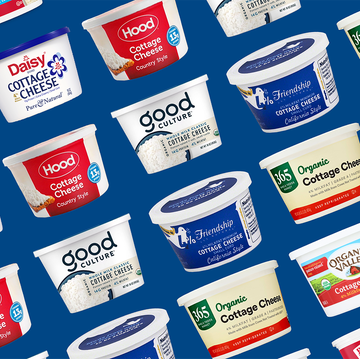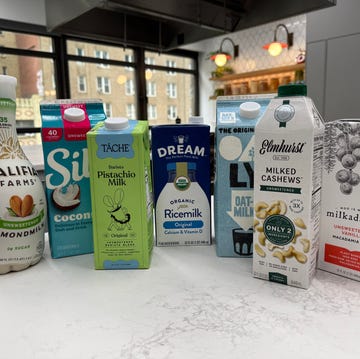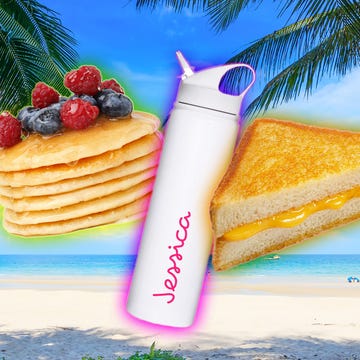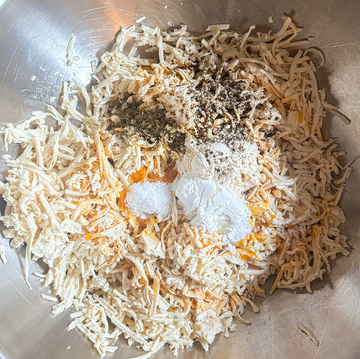Most of us at Delish were Fireball virgins up until about 8 months ago. But the obsession started—as nearly all wicked things do—at a bachelorette party. "I went to three in a span of a few weeks, and at literally at every single one, some girl would shout out, 'Oh my god, let's do a round of Fireball shots!" says senior editor Candace Braun. Soon after, Candace found herself at a family holiday party, where someone's little old grandmother pulled out a bottle and yelled, "Let's get this party started!" "It was at that point that I realized this stuff had universal appeal."
The next day in the Delish kitchen, Candace pitched a video idea: Cinnamon Roll Fireball Shots—Fireball whiskey mixed with cream soda and whipped cream. Some of us chuckled. Most patronized her with interest. But no question: all of us were confused. What WAS this stuff? We decided to move the idea forward—then we posted the video, and watched the universe ignite. The video had 32 million views and over 1.1 million shares on Facebook in a matter of few weeks.
Just saying the word "Fireball" most likely caused you to have one of two responses. Either your mouth watered at the thought of that Big Red-in-a-bottle sting, or your eyes rolled at the mention (how can it call itself "whiskey" and share a shelf with real spirits?). In either case, it's tough to deny the allure of Fireball—or ignore its truly unprecedented spike of success.
If it seems like Fireball came out of nowhere, that's because it did. The brand had sales of $1.9 million in 2011, and $130 million by 2014. (Those numbers, by the way, reflect retail sales alone. It doesn't take into account the purchases that are made secondhand—that is, via shots at bars.) In half a decade, Fireball has shot up the list of best-selling liquors in the U.S.; it now rests comfortably in the top 10, beating out legacy names like Jim Beam and Jose Cuervo.
It may be surprising to learn that Fireball has actually been around since the 1980s, when the formula was sold under the name Dr. McGillicuddy's Fireball Whisky. The spicy cinnamon liquor and its ability to instantly heat up your insides made it a great fit in Canada, the only country where it was sold. The whiskey's twenty-first century renaissance began when the New Orleans-based Sazerac Company (otherwise best known as the distributor of Pappy Van Winkle's bourbon) rebranded the formula in 2007. They removed the elderly Dr. McGillicuddy from the label, replacing him with a red devil, and shortened the name. And they put one very special man to work: Richard Pomes.
In mid-2010, when he was college-aged himself, Pomes became Fireball's brand ambassador. The company gave him one mission: give young people free shots. He hit up bars, typically in the South, typically in college towns, and bought shots for huge groups of revelers. It was that simple, and that brilliant (though they'll never admit it; Sazerac is a private company that rarely, if ever, does press, including for this story).
Esteban McMahan works at a college bar, the TOPO Restaurant, Brewery, and Distillery in Chapel Hill, NC, which sits within blocks of the UNC-Chapel Hill campus, and began stocking the stuff when his young clientele demanded it. "Fireball displaced Jager for the party scene," he remembers, but it wasn't all kids. "People in their thirties and forties order it though, too, when they're out with their buddies. Fireball is the celebratory shot."
Pomes' efforts represent the most old-fashioned type of marketing: word of mouth. His mission accomplished, he moved on in 2012, creating his own agency and serving such clients as the city of New Orleans itself. In the following years, Fireball continued to bypass traditional print or television advertising, and instead capitalized on that newest form of marketing: social media.
The brand's web voice is that of a lovable scamp. Other spirits aim to seem untouchably cool, like Dos Equis' The Most Interesting Man in the World, while whiskey companies fall all over themselves trying to prove how authentic they are, as with Jim Beam's suggestion that Civil War soldiers chugged the stuff to survive amputations. Fireball doesn't even have print or broadcast advertising, so their social media tells the whole story. Their persona sounds excited and happy; they root followers along to the weekend and post endless fire puns. Their Twitter account even flirts with the accounts of other millennial-friendly companies, such as Ann Taylor LOFT and Taco Bell.
The internet loves Fireball right back. In an age when every advertising agency is brainstorming how to engineer virality—see wacky, must-share campaigns like Mountain Dew's #Puppymonkeybaby or Android's Friends Furever—consumers craft content on Fireball's behalf. Pinterest is packed with recipe suggestions, whether liquid or solid, and there are #FireballFriday memes for any pop-culture reference. A video of little old ladies sampling Fireball (and of course, loving it) got 3 million hits last December.
That digital fanaticism was never more clear than when, in the fall of 2014, news broke that Fireball had been banned in Europe over one of its ingredients, which is also a part of antifreeze. Cue utter internet meltdown, and a lot of confusion. The whiskey was recalled in Norway, Sweden and Finland after a batch of the North American formula went to Scandinavia by mistake. That key chemical, propylene glycol, is only legal in Europe in slim proportions, while the U.S. is a little looser in their requirements. Our Food and Drug Administration says it's "generally recognized as safe," and Fireball released a statement to let everyone know that, like, you need to chill. "Fireball is perfectly safe to drink. Just as it always has been," they snapped.
Of course, with great success comes many other haters. Whiskey aficionados love to claim that this stuff barely counts as whiskey—in fact, most that we asked to interview for this story reacted with full-blown contempt. "It has certainly gotten people who don't consider themselves 'whiskey drinkers' to drink whiskey," says Mark Bowman, the manager at the Oak Bar in Nashville (and one of the few whiskey lovers willing to discuss the fiery stuff). "But it also created a fad that has seen the market flooded with flavored whiskeys of low quality: high in sugar and artificial flavors, almost too easy to drink. There are probably a whole lot of consumers out there who will never touch whiskey again because of a night or two of too much Fireball, or one of the new flavored whiskey products that followed in its wake."
And follow they have. Multiple cinnamon-flavored whiskies have hit the market in recent years (see box), and these releases are one area where the Sazerac Company isn't afraid to make some noise. They filed five complaints in the 2014 and 2015 alone, arguing against abuses such as the use of a similar devil logo (SinFire Cinnamon Whiskey) and even the manipulation of Google ads (Jack Daniel's), so that a consumer searching for the term "fireball" sees their Tennessee whiskey instead. Sazerac dropped or settled all of the suits, which seems to suggest their main goal is to make a point.
Try as they might, it'll be difficult to stop the Fireball train of brand recognition. In five years, the whiskey has created a shorthand that other labels take decades to earn: as with Kleenex, Oreos, Bandaids, Coke, the item is the brand. The brand is the item. When you hit a bar with friends, you order a round of tequila, or lemon drops, or beers. Or the capital F of Fireball.
It's easy to see why everyone wants to replicate that—but even that said, the more crowded the party gets, the more some people want to leave it. Beth*, 20, a college sophomore, claims the whiskey is pretty lame, even embarrassing, on her campus in New England. "I drink better than that," she says. "I believe there is a stigma attached to it, like Malibu [rum]. It's for those who can't handle straight alcohol."
Items are 'basic' when they're easy to like, easy to consume, easy to rally around. "I have always said that when it comes to wine, the only thing that matters is whether or not you like what's in your glass (or cup!)," says Bowman. "In that sense, Fireball is a great product because it makes a lot of people happy."
*Name changed to protect the underage drinker.
